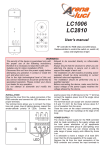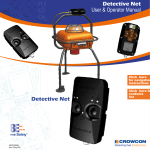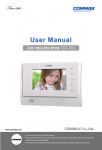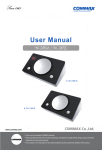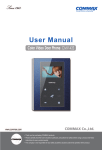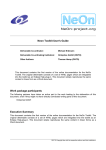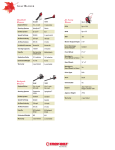Download У]о:(mЧєь{Сr˙„~®M −Ї‹ОЄ* hˇОˆt
Transcript
Service Manual 32cc String Trimmer Power Head NOTE: These materials are for use by trained technicians who are experienced in the service and repair of outdoor power equipment of the kind described in this publication, and are not intended for use by untrained or inexperienced individuals. These materials are intended to provide supplemental information to assist the trained technician. Untrained or inexperienced individuals should seek the assistance of an experienced and trained professional. Read, understand, and follow all instructions and common sense when working on power equipment. This includes the contents of the product’s Operators Manual, supplied IMPORTANT: READ SAFETY RULES AND INSTRUCTIONS CAREFULLY with the equipment. No liability can be accepted for any inaccuracies or omission in this publication, although care has been This itService Manual not a substitute Manual.However, You must taken to make as complete andisaccurate as possiblefor atthe the Operator’s time of publication. dueread, to theunderstand variety of outdoor power equipmentand andfollow continuing changesin that occur over time, updates be made toManual these instructions from time to time. all ofproduct the directions this manual as well as thewill Operator’s before working Therefore,on it may be necessary to obtain the latest materials before servicing or repairing a product. The company reserves the this power equipment. right to make changes at any time to this publication without prior notice and without incurring an obligation to make such changes to previously published versions. Instructions, photographs and illustrations used in this publication are for reference use only and may not depict actual model and component parts. © Copyright 2005 MTD Products Inc. All Rights Reserved MCCULLOCH CORPORATION P.O. BOX 31567, TUCSON, AZ 85751-1567 MTD Products LLC - Product Training and Education Department PRINTED IN USA FORM NO. 769-00942 (10/2003) McCulloch 32cc Trimmer 1. INTRODUCTION 2.3. North American distribution rights to the McCulloch product line are new to MTD for the 2004 season. The trimmers are similar in some ways to the MTD SouthWest (RYOBI) products that we have offered for the past three years. Another trimmer head that is used on McCulloch string trimmers resembles a cross between the MTDSW Speed Spool and the MTDSW Tap-NGo head. See Figure 2.3. The architecture of both units is based on a cantilever crankshaft. The McCulloch is piston ported, while the MTDSW engine has a reed valve. Some of the service techniques are similar, but not identical. 2. TRIMMER HEADS 2.1. One trimmer head available on the McCulloch products is nearly identical to the MTDSW TapN-Go. The operating principle is the same, but the parts are different enough that they are not fully interchangeable. See Figure 2.1. McCulloch trimmer head with simplified loading McCulloch version of small tap-n-go Figure 2.3 2.4. A refill consists of 15’ - 20’ of .080” trimmer line. 2.5. To install line, cut it to length. Two equal-length half-portions may be used, or one full length line may be installed, then trimmed after installation. See Figure 2.5. Figure 2.1 2.2. There is also a McCulloch version of the large tap-n-go head. It is used on the straight shaft trimmers, and rotates in the opposite direction of the small one. Single-length method Figure 2.5 1 McCulloch 32cc Trimmer 2.6. 2.8. Align the arrows on the spool with the arrows on the housing. See Figure 2.6. From the eyelet, the line will be channeled up under the bump knob by a set of ramps in the spool. See Figure 2.8. Housing Spool Ramps Arrows (marked for clarity) Bump knob removed for clarity Anchors Bump knob Figure 2.6 Figure 2.8 2.7. Insert a length of trimmer line through each eyelet. There are two sheaves for line in the spool, separated by a narrow groove. The line must enter the narrow groove. See Figure 2.7. 2.9. The ends of the line are looped-through the anchors to hold them in place, then pulled-tight. NOTE: With the arrows aligned, the line can also be installed from the inside-out, by removing the bump knob. Eyelet 2.10. The final step is to rotate the spool in the direction indicated by the arrows, drawing the line into the head. See Figure 2.10. Inset: arrow on spool, marked for clarity Center groove Figure 2.7 Figure 2.10 2.11. Stop winding when each end of the line is about 6” long. 2.12. Press the bump knob and pull on the line to manually test the trimmer head. Do not push the housing off it’s seat while testing. 2 McCulloch 32cc Trimmer 2.13. If repair is required, remove the bump knob, and withdraw the spool. See Figure 2.13. 2.17. The ratchet wedges can be serviced by removing the three screws holding the black cover to the top of the housing. See Figure 2.17. Ratchet wedges Small springs behind Spring Holes for screws Ribs Tabs Cover Figure 2.13 Figure 2.17 2.14. Check for: tangled line, damaged tabs on the spool, worn ribs on the spool, missing spring, broken ratchet wedges. 2.18. Carefully remove the springs, and pull out the wedges. See Figure 2.18. 2.15. Replace the spool if it is worn or damaged. NOTE: Bump knobs are a wearable item, and are replaced in the course of normal use. 2.16. The housing is not fastened to the boom. It simply rests over a hexagonal drive collar. See Figure 2.16. Spring seats over post on back of wedge One rounded side, insures correct orientation Drive collar Figure 2.18 Figure 2.16 3 McCulloch 32cc Trimmer 3.3. 2.19. When properly installed, the wedges should be spring loaded. They retract when the ribs on the back of the spool pass them, then extend to keep the spool from rotating backwards. See Figure 2.19. To separate the powerhead from the boom, remove the screw at the top of the grip using a T25 driver, then withdraw the boom. See Figure 3.3. Trigger housing and grip slip off of boom Spring loaded ratchet wedges Screw removed Figure 3.3 Figure 2.19 3.4. 3. RECOIL STARTER 3.1. Next to the cutting head, this is probably the most common service item on the trimmer. It is similar in principle to the MTDSW starter, but the routing of the throttle and stop switch cables necessitates a slightly different approach. 3.2. The throttle trigger, stop switch, and grip can all be removed from the boom in unit with the power-head. See Figure 3.2. Remove the air filter cover using a T-25 driver to gain access to the connection between the throttle cable and the throttle arm on the carburetor. See Figure 3.4. Air filter cover Screw holds grip and Throttle housing to boom Figure 3.4 Positioning mark Figure 3.2 4 McCulloch 32cc Trimmer 3.5. Disconnect the throttle cable from the carburetor by unhooking the Z-fitting at the carburetor end of the cable. See Figure 3.5. 3.7. Remove the two screws from the trigger housing cover using a T-15 driver. See Figure 3.7. Stop switch Throttle arm on carburetor Trigger housing cover screws Trigger housing Z-fitting on end of throttle cable Trigger housing cover Figure 3.7 Figure 3.5 3.8. 3.6. After the powerhead is separated from the boom, and the throttle cable is slackened, the housing that contains the stop switch and throttle trigger can be separated from the grip. Push the front part of the housing forward to remove it. See Figure 3.8. Grip Trigger housing slips out of grip NOTE: Alternatively, instead of removing the complete powerhead and grip from the boom, the clutch housing can be separated from the starter housing. If this approach is taken, the stop switch wires must be disconnected as the two sections are separated. The throttle cable will pull out of the starter housing and clutch housing as the powerhead is removed. Because of the difficulty of routing the throttle cable back through the housings, a wire or string should be connected to the z-fitting so that the throttle cable can be “fished” back into place. Stop switch contacts Stop switch mounted on cover plate Figure 3.8 3.9. The throttle trigger will be released from its pivot point, and the stop switch will remain with the rear portion of the housing. NOTE: The stop switch contacts two rub strips to ground-out the ignition module. One rub strip is connected to the primary windings of the module, the other leads to ground. 5 McCulloch 32cc Trimmer 3.12. The grip and clutch housing can be separated from the engine by removing the four screws that fasten them together, using a T-25 driver. See Figure 3.12. 3.10. The trigger housing can be pulled-free of the grip after the trigger and rear housing are removed. See Figure 3.10. Channel for throttle cable Channel for stop switch wires Stop switch wires Clutch housing Starter housing White plastic sleeve NOTE:The grip is integral with the clutch housing Figure 3.10 Figure 3.12 NOTE: The throttle cable and stop switch wires are held in adjacent channels by a white plastic sleeve that is inserted in the grip. 3.13. Remove the grip and clutch housing, and unplug the stop switch wires from their connections on the engine. See Figure 3.13. 3.11. Pull the white sleeve out of the grip and unplug the stop switch wires from their connections to the contact strips in the trigger housing. See Figure 3.11. Channel for stop switch wires Channel for throttle cable Remove sleeve Figure 3.13 NOTE: Pay attention to the routing of the throttle cable and stop switch wires. Figure 3.11 3.14. Disconnect the H.T. lead from the spark plug. and remove the spark plug using an 5/8” wrench. 3.15. Pack the cylinder full of starter rope to act as a piston stop. 6 McCulloch 32cc Trimmer 3.16. Remove the clutch drum using a T-25 driver. See Figure 3.16. 3.18. The flat side of the clutch rotor seats against a tube that surrounds the crankshaft. See Figure 3.18. Recoil rope used as a piston stop Flat side of clutch rotor faces starter housing Tube Clutch drum Figure 3.16 Figure 3.18 3.17. After the clutch drum is removed, the clutch rotor can be removed using MTDSW clutch removal tool # 791-180919. See Figure 3.17. 3.19. With the clutch rotor removed, the starter housing can be removed. 3.20. Take out the four screws holding the starter housing to the engine using a T-25 driver. See Figure 3.20. Throttle cable Crankshaft Clutch rotor Starter housing Spade terminals for stop switch wires Screws Figure 3.17 NOTE: a hammer and soft drift can be used if the MTDSW tool is unavailable. Figure 3.20 7 McCulloch 32cc Trimmer 3.23. Alternatively, the throttle cable could be disconnected from the engine by squeezing the tabs, and removing it along with the starter housing. See Figure 3.23. 3.21. Unplug the stop switch wires from the ignition module as the starter housing is removed from the engine. See Figure 3.21. Stop switch wires Squeeze tabs Starter housing Ignition module Figure 3.21 Figure 3.23 NOTE: There are two sets of stop switch wires. The set inside the starter housing connects to the ignition module. The set of stop switch wires in the clutch housing connects the set inside the starter housing to the stop switch. NOTE: If a throttle cable needs replacement, attach a line to the carburetor end of the old cable before removal, to facilitate “fishing” the replacement cable into place. 3.24. Remove the baffle from the starter housing using a T-25 driver. 3.22. The throttle cable is best left in the starter housing as it is removed. This can be done by simply rotating the starter housing out of the way. See Figure 3.22. NOTE: The starter pulley is held in place by the baffle. There are no other fasteners on it. Starter housing removed 3.25. Once the baffle is removed, the starter pulley can be carefully lifted out to access the recoil spring. See Figure 3.25. Stop switch wires Posts Throttle cable Figure 3.22 Baffle Figure 3.25 8 McCulloch 32cc Trimmer 3.30. As the starter is reassembled, apply a sparing amount of white lithium grease to the friction surfaces of the starter pulley. NOTE: If the starter rope is not broken, it will be necessary to relieve tension from it before removing the starter pulley. 3.31. Pay close attention to the routing of the stop switch wires. 3.26. Examine the pulley and spring for wear and damage. Look for straightened ends on the spring. Look for rounded edges on the teeth of the starter pulley. See Figure 3.26. Starter pulley 3.32. Wind tension onto the starter rope after the pulley is in place, but before the baffle is installed. It will be necessary to use caution nut to pull upward on the rope, dislodging the pulley from the spring. Light thumb pressure on top of the pulley is advised. See Figure 3.32. Spring cover Spring ends Figure 3.26 3.27. When installing new starter rope, use about 6’ of 3/16 starter rope. Figure 3.32 3.28. After the starter pulley is removed, the starter spring can be lifted out of the starter housing, complete with the steel cartridge that contains it. See Figure 3.28. 3.33. If the starter pawls on the flywheel are worn or damaged, remove the flywheel. See Figure 3.33. Spacer Tube Nut Flywheel Starter spring in cartridge Notches engage end of spring Starter pawls Plastic shield Figure 3.33 Figure 3.28 NOTE: In particular, look for rounded edges on the corners of the pawls that engage the teeth on the pulley. 3.29. There is a plastic shield that fits between the starter pulley and the starter spring. 9 McCulloch 32cc Trimmer 3.39. If the pawls are damaged, they are available as a pair, with mounting hardware, in kit form. See Figure 3.39. 3.34. Remove the spacer and tube from the crankshaft. 3.35. Remove the nut from the crankshaft using a deep 11/16” socket. See Figure 3.35. Starter pawl Tube Damaged edge Spacer Crankshaft Nut Figure 3.39 Figure 3.35 3.40. Release the retainers on the back side of the flywheel to remove the starter pawls. See Figure 3.40. 3.36. Pry up on one thick section of the flywheel, and strike the opposite side with a soft dead-blow hammer. See Figure 3.36. Pawl retainers Threads for clutch rotor Threads for nut Key Tapered seat Figure 3.40 Figure 3.36 3.41. After replacing the pawls or the flywheel, carefully seat the key and flywheel back on the crankshaft. 3.37. Lift the flywheel off of the crankshaft, using caution not to lose the flywheel key. 3.42. Install the nut, and torque it to xx in-lbs., then place the spacer and tube back over the crankshaft. 3.38. If the flywheel has any chips, cracks, or broken vanes, discard it. Re-using a damaged flywheel presents a burst hazard. 10 McCulloch 32cc Trimmer 3.43. Removing the starter housing will also allow access to the ignition module. If the ignition module is removed for any reason, the air-gap must be adjusted with the flywheel securely fastened. See Figure 3.43. 3.46. As the starter housing goes-on, connect the short lengths of stop switch wire that are inside the starter housing to the ignition module, and clip the throttle cable into the hole in the engine case. See Figure 3.46. Check air gap Throttle cable Male spade terminals for stop switch wires Figure 3.43 Figure 3.46 3.44. Set the air gap to .014” using a non-magnetic feeler gauge. 3.47. Secure the starter housing to the engine. 3.48. Install the clutch rotor and drum. See Figure 3.48. 3.45. After the starter is assembled, carefully position the starter housing, throttle cable, and stop switch wires, and install the starter housing to the engine. See Figure 3.45. Stop switch wires Throttle cable Figure 3.48 Figure 3.45 11 McCulloch 32cc Trimmer 4. 3.49. Connect the stop switch wires in the clutch housing to the male spade terminals on the ends of the stop switch wires in the starter housing, and position the throttle cable as the clutch housing is lowered into place. See Figure 3.49. EXHAUST If the fuel/oil mixture is too rich, the exhaust port and muffler may accumulate deposits of carbon. These deposits will hinder high-R.P.M. engine performance and increase operating temperatures. Eventually, they may lead to a no-start situation. There is a characteristic “flat” tone to the exhaust noise that accompanies a blocked exhaust. 4.1. The engine cover must be removed to gain access to the muffler. See Figure 4.1. Air filter cover Engine cover Engine cover screw Figure 3.49 D-shaped washer NOTE: The wires and cable should be positioned as they were in Figure 3.13. 3.50. Secure the clutch housing to the starter housing. Figure 4.1 3.51. Position the throttle cable and stop switch wires as they were in Figure 3.11. 3.52. Insert the white plastic sleeve into the grip. 3.53. Connect the carburetor end of the throttle cable, then assemble the throttle trigger housing. 4.2. Disconnect the high tension lead form the spark plug. 4.3. Remove the air filter cover using a T-25 driver. See Figure 4.3. 3.54. Install the power-head on the boom. Engine cover screw Air filter Figure 4.3 4.4. 12 This will allow access to the screw that secures the carburetor side of the engine cover. McCulloch 32cc Trimmer 4.5. Remove the three screws that secure the engine cover, using a T-25 driver. See Figure 4.5. 4.8. The muffler can be easily removed by unhooking the spring and bale that retain it. See Figure 4.8. Round washer Hook on cylinder Bale Screw Spring Figure 4.5 Figure 4.8 NOTE: the screw on the exhaust side of the engine has a plastic washer. The screw on the back side of the engine has a round steel washer. The screw on the carburetor side of the engine cover has no washer. 4.6. 4.9. With the engine cover removed, the spark arrestor and muffler are accessible. See Figure 4.6. Rotate the bale upward to liberate the muffler, muffler gasket, and port gasket. See Figure 4.9. piston skirt Muffler Exhaust port Spark arrestor Figure 4.9 NOTE: The exhaust port provides an ideal window into the cylinder to inspect the condition of the piston skirt and the cylinder wall. Figure 4.6 4.7. 4.10. Bale fits just beneath the largest cooling fin on the cylinder, and hooks into the cylinder. Rotate it to unhook it. The spark arrestor is easily removed for cleaning or replacement using a phillips head screwdriver, or a nut driver. 4.11. Clean the muffler and port if necessary, using care not to damage the piston or knock carbon into the cylinder. NOTE: The spark arrestor consists of a screen, a cover, and a screw. It is available as a kit. 13 McCulloch 32cc Trimmer 5. 4.12. Install the muffler using a new gasket. See Figure 4.12. FUEL SYSTEM Carburetor repair is beyond the scope of this manual, but service information is available from Walbro and Zama, the manufacturers whose carburetors are used on McCulloch products. 5.1. The fuel filler cap contains a polymer “stone” tank vent. If it becomes blocked, the tank may pressurize when heat-soaked, flooding the engine. 5.2. The opposite situation may occur if the engine is run with a blocked tank vent. Air will be unable to enter the tank to replace the fuel that is consumed by the engine. This will create a vacuum, and fuel starvation will occur. See Figure 5.2. exhaust gasket Figure 4.12 4.13. Install the engine and air filter covers, and connect the high tension lead to the spark plug. 4.14. Test run the unit before returning it to service. NOTE: The engine can be test-run briefly with the muffler removed. Hearing protection is strongly suggested. Extended running (30 seconds or more) is not recommended without the engine cover and muffler in place. Fuel cap vent Wet-bulb primer Figure 5.2 5.3. The air filter cover is easily removed using aT-25 driver. See Figure 5.3. Figure 5.3 14 McCulloch 32cc Trimmer 16



















